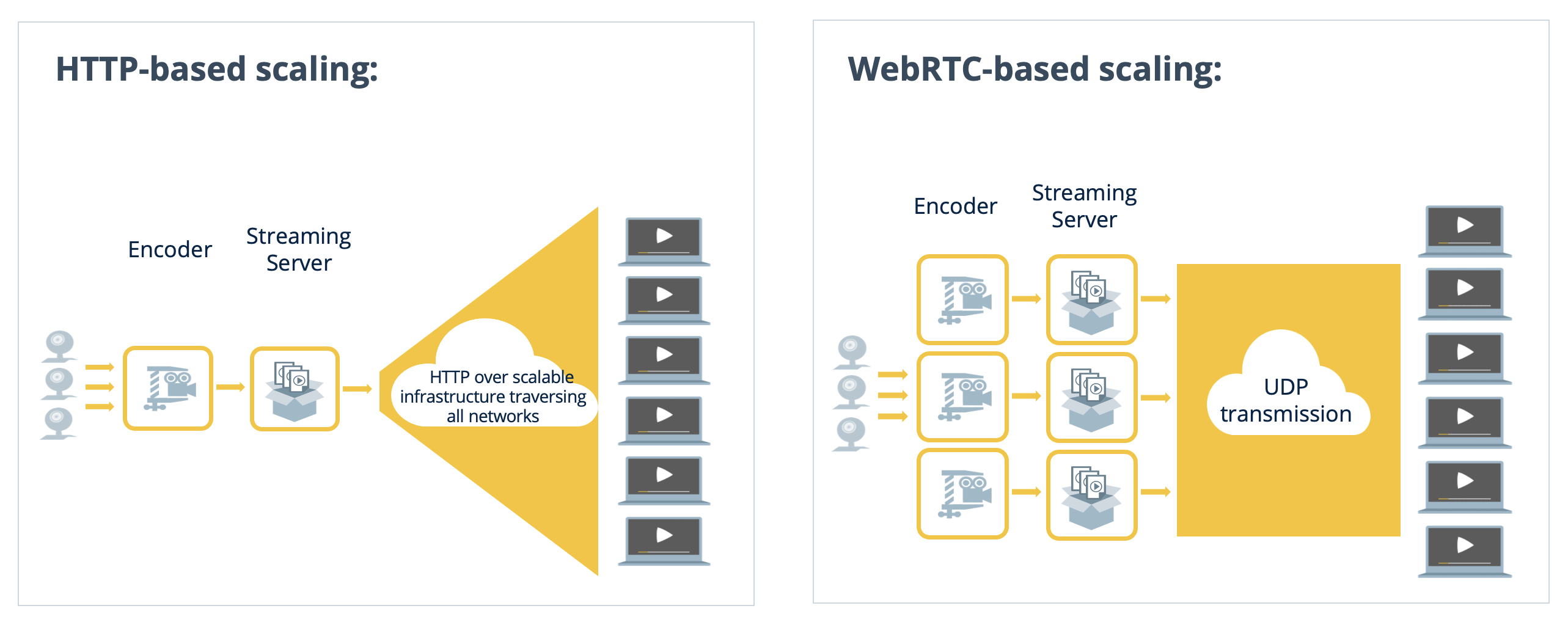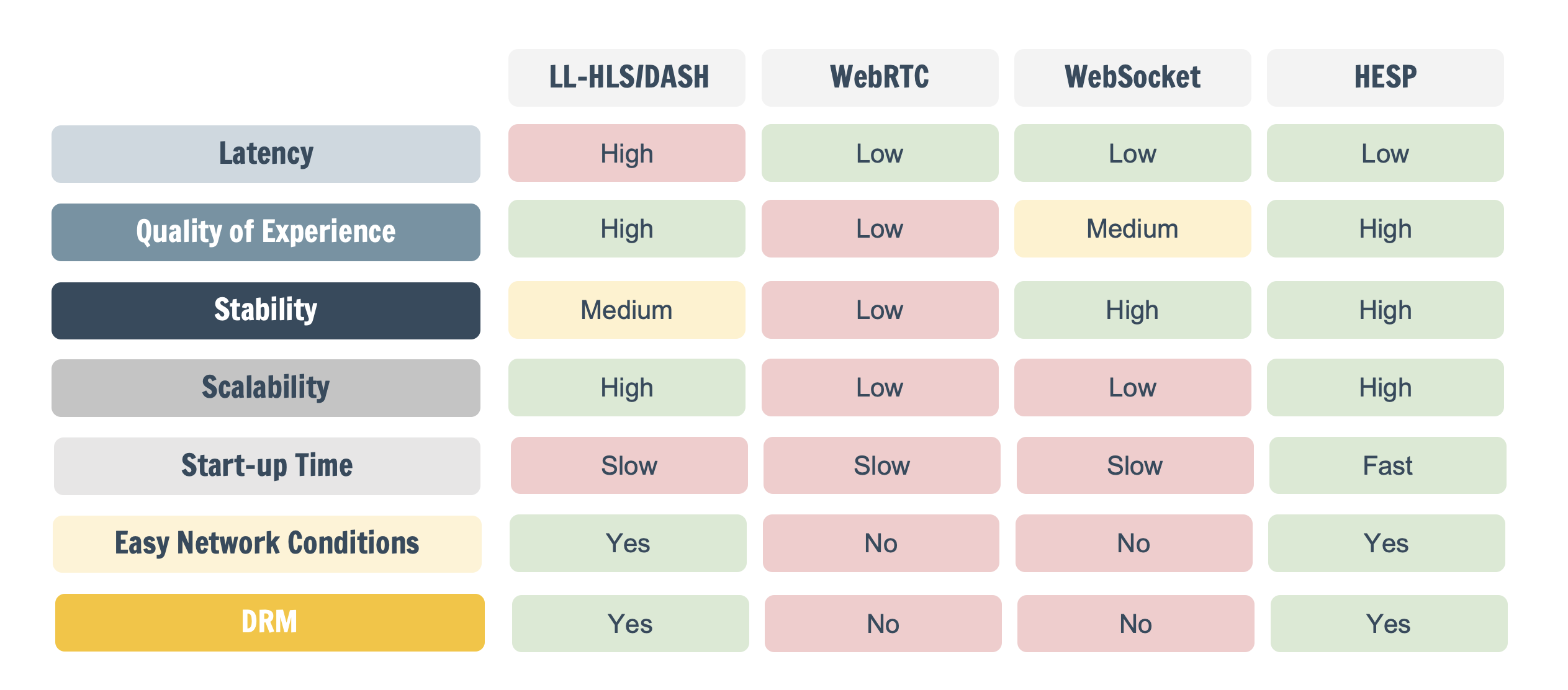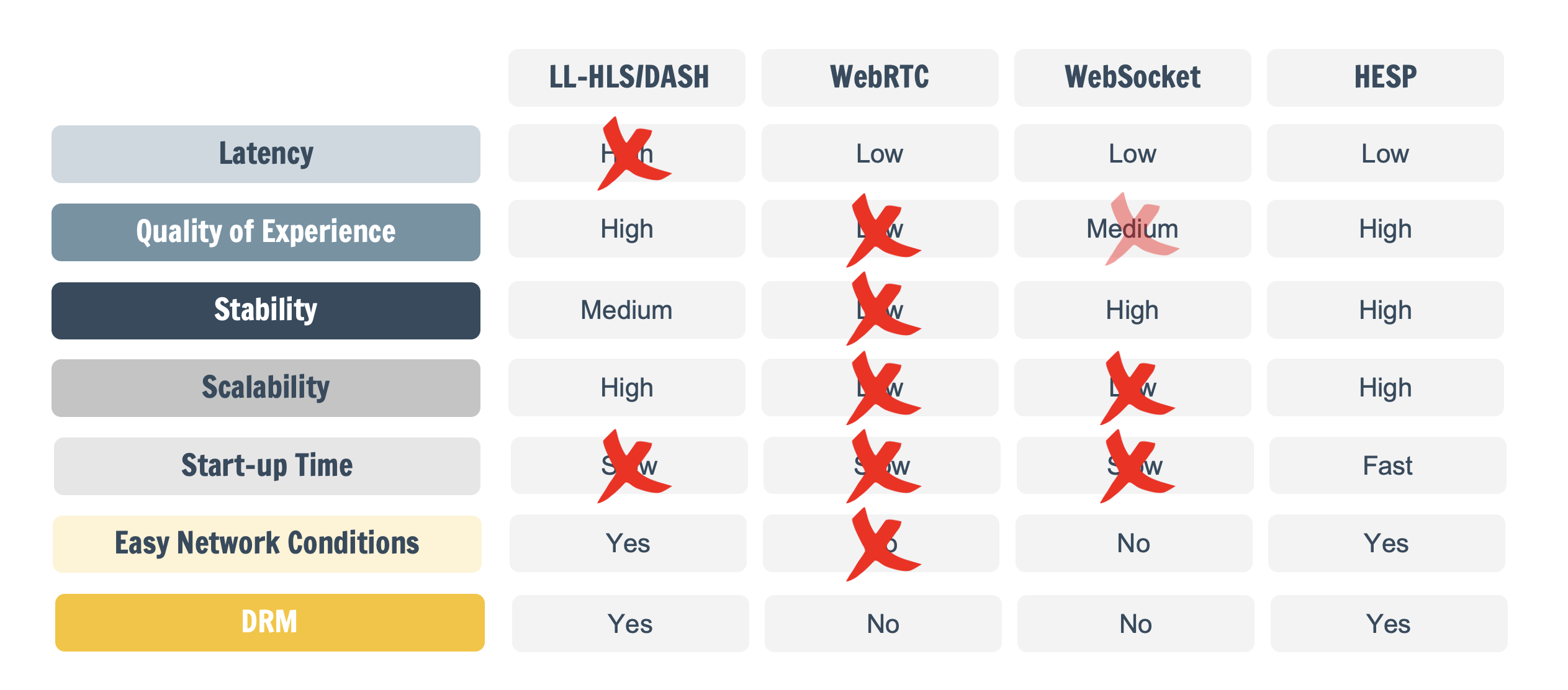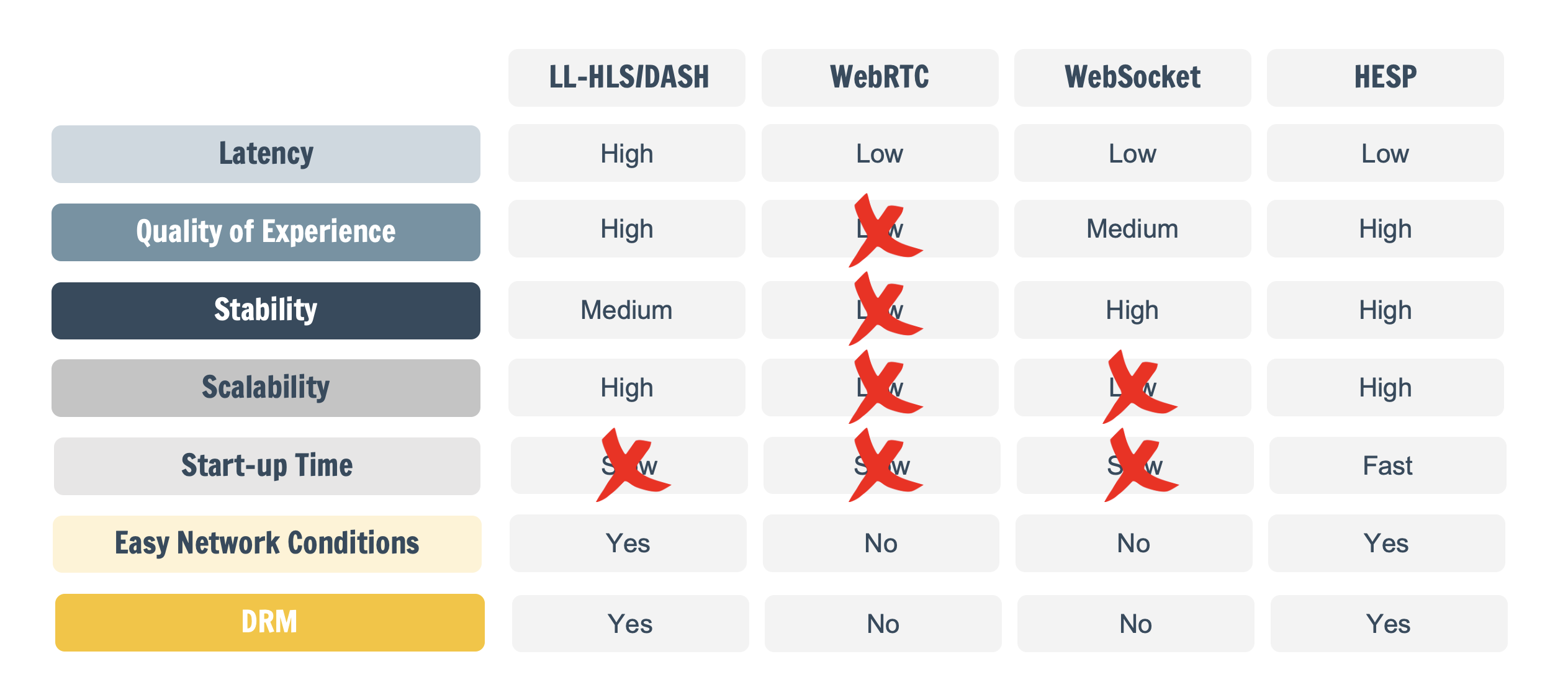Share this
How live dealer casino games can achieve real-time streaming without sacrificing quality and stability for their players
by Bart Van Oosterhout on July 7, 2023
The iGaming industry relies on real-time streaming to enhance player-dealer interaction and increase profits for live dealer casino game providers. However, achieving this low latency can come at a cost to video quality, stability or scalability. Players are more demanding than ever, and expect a high-quality video experience similar to that of popular streaming services. As a result, many live dealer casino game providers are striving to improve their video experience to match that of OTT streaming services.
In this article we’ll cover:
- Streaming requirements for live dealer casino games
- Approaches for real-time video streaming used by live dealer casino games
- How to select the right video streaming approach for your use case

1. Streaming requirements for live dealer casino games
a. Latency
The mathematics behind live dealer casino games is straightforward: the lower the video streaming latency, the more rounds of play can be completed. Since the cost for the studio, host, and technical staff is fixed, increasing the number of rounds leads to increased revenue and profit. Most iGaming providers target sub-second latency.
It’s important to note that live dealer casino games have varying latency needs. Games that rely on player decisions, such as card games, will perform better with sub-second latency. While roulette can still be played with higher latency, a lower latency allows for more bets to be placed and thus more profit to be made. A game like the vertical wheel, which is popular for its high concurrency, does not necessarily require ultra-low latency, but it needs to be able to handle a large number of simultaneous viewers.


Figure 1: Live dealer casino games have varying latency needs
Another factor to consider when discussing latency is the location of your players. In countries with less stable network infrastructure, such as Brazil, India, or the Philippines, some providers may use a higher latency approach to ensure an acceptable viewing experience.
b. Quality
Players of live dealer casino games are increasingly demanding as their quality expectations are set by popular streaming platforms. For example, Twitch streams in full HD at 6Mbps; YouTube already offers 12Mbps today.
There are several key factors that determine a player's quality of experience.
- First, resolution is important. The game should be optimized for the player's device screen. There is no need to show full HD on a smartphone, but it makes sense on an iPad Pro or a smart TV, for example.
- Second, bitrate goes hand in hand with resolution to form the essentials for delivering an Adaptive Bitrate (ABR) ladder. ABR delivers an optimal viewing experience for any network condition. For iGaming, it is not always applied at the moment.
- Third, frame rate is often overlooked in live dealer casino games. Studios today can produce at 50-60 frames per second (fps), but often distribute at lower fps.
- Lastly, start-up time is also crucial. There is nothing more frustrating for a player than waiting to play. Fast start-up times can also give additional benefits when switching between landscape and portrait mode video, especially when you can handle this in the same time as the user rotates its device.
While a nice studio setup, presenters, and interesting games are a minimum requirement to attract players, a high quality of experience will keep them engaged.
c. Stability
The last mile delivery of real-time casino games to players is something which cannot be controlled, as you’re dependent on existing networks worldwide. In some regions such as Southern Europe, Latin America, Africa or Asia, you need to consider how you want to deliver.
It’s important to avoid frame drops in your delivery, as these have a direct impact on the quality of experience and the number of hands which can be played. Some protocols drop frames as they do not use ABR to compensate for changing network conditions.
Also, mobile operators often block UDP traffic on their networks when it starts congesting. This is something to consider, as you don’t want your live casino game to stop streaming when players are located in a busy city center, or when an important event such as the World Cup football takes place.
d. Security
The last key factor is content protection. Most live dealer casino game streaming happens with clear content at the moment. This means that anyone can take your content, potentially steal and re-stream it, and use it for cheating.
Basic tokenization is a first layer of protection used by live dealer casino games. However, it's important to make sure that it's fully integrated with your backend to grant access. Otherwise, it can be easily hacked. To ensure maximum security, it's best to work with a video streaming service that integrates the tokenization flow with your user management system.

On top of these protection layers, you may also need to consider geoblocking. It allows you to restrict streaming access to specific geographic regions or personalize content by incorporating different graphics tailored to particular regions. This versatile approach proves valuable across various use cases, ensuring that your content remains accessible solely to your intended audience. By employing geoblocking, you can have peace of mind knowing that your content is viewed exclusively by the individuals you intend to reach.
2. Approaches for real-time video streaming used by live dealer casino games
a. HLS & DASH
HLS and MPEG-DASH are protocols designed for streaming high-quality content to large audiences. While these protocols offer high quality of experience, they have a significant disadvantage in terms of latency. These protocols work by chopping up a long video stream into segments of 10 seconds or more, which requires the video client to download a complete segment before it can be played, introducing latencies of 10-45 seconds. The low latency variants, LL-HLS and LL-DASH reduce latency to 3-7 seconds. However, further reducing the latency to achieve stable and high-quality real-time streaming, i.e. sub-second latency, is not possible. The HLS and DASH formats do offer content protection, including support for studio-approved DRM solutions.
b. WebRTC
WebRTC is a real-time communication protocol that was specifically designed for web-based communication needs. It provides faster communication through the use of the UDP protocol, but it does bring susceptibility to frame drops due to network congestion and a lack of DRM protection. Also, the architecture of WebRTC uses a point-to-point connection between the streaming server and the clients, which makes it complex and expensive to scale. Instead of using a standard CDN like traditional HTTP-based streaming protocols, it scales through spinning up additional streaming servers in the backend.

Figure 2: WebRTC based scaling vs HTTP-based scaling
c. WebSocket
WebSockets brings a similar architecture as WebRTC including its scaling challenges. Compared to WebRTC, it does bring a lower risk of frame drops, better perceived quality, and compatibility with a range of browser types as advantages. In short, video quality of a WebSocket based approach is higher than WebRTC, but lower than HTTP-based approaches such as HLS, DASH and HESP. Additionally, WebSockets still brings issues with sometimes very slow start-up times (up to 5 seconds) and lack of support for studio-approved DRM.
d. HESP
The High Efficiency Streaming Protocol (HESP) is an HTTP-based streaming protocol designed for delivering premium content with sub-second latency. It can easily scale over standard Content Delivery Networks (CDN), just like HLS and DASH, making it suitable for both small and large audiences, including global distribution to thousands of viewers. In addition to delivering high-quality content at sub-second latency, HESP also brings a fast channel start-up and support for studio-approved DRM.
3. How to select the right video streaming approach for your use case
As an iGaming provider, how do you choose the right video distribution approach for your use case, and what are the criteria to take into account?
When choosing the right protocol for delivering your video stream, it is important to consider the use case and make a decision based on the criteria that are most important for you e.g. latency, viewer locations, scalability, channel start-up time, and requirements for DRM, if cheating would be common in the regions that you are streaming.
The matrix provided below can assist in identifying the optimal approach for each use case.

Figure 3: Decision matrix to see which streaming technology best fits your use case
Example 1: Roulette game to Eastern European customers
In a roulette game, achieving sub-second latency is the ideal scenario, although working with slightly higher latencies can still be acceptable. Video quality and stability are important, given the immersive nature of the game. Considering the game's high concurrency, scalability becomes a crucial factor. Additionally, fast start-up time is highly valued. In Eastern Europe, the risk of cheating is relatively lower, which makes DRM less of a necessity in this particular case.

Figure 4: Example decision matrix for a roulette game in Eastern Europe
Example 2: Card game to APAC region
In this use case, low latency, high-quality video, and stability are top priorities. Scalability will not be a critical factor for a card game unless it gains significant popularity. Given the importance of network conditions in this region, ensuring a smooth and reliable streaming experience is crucial. Lastly, prioritizing security is paramount, making DRM the optimal choice for safeguarding the game content in this scenario.

Figure 5: Example decision matrix for a card game in APAC
Example 3: Wheel of Fortune to EU/USA market
When delivering the Wheel of Fortune game to European and USA geographical regions, latency becomes less critical, allowing for various protocols to function effectively. However, ensuring high-quality and stable gameplay remains vital for an exceptional viewer experience. Given the game's popularity, scaling capabilities should be optimized to accommodate increased demand seamlessly. Additionally, network conditions in these regions are typically favorable, reducing the risk of interruptions. While the risk of cheating may be lower, maintaining security measures remains important to preserve the integrity of the game.

Figure 6: Example decision matrix for a wheel of fortune game in EU/USA
Share this
- THEOplayer (46)
- online streaming (40)
- live streaming (35)
- low latency (32)
- video streaming (32)
- HESP (24)
- HLS (21)
- new features (21)
- THEO Technologies (20)
- SDK (19)
- THEOlive (17)
- best video player (17)
- cross-platform (16)
- html5 player (16)
- LL-HLS (15)
- online video (15)
- SmartTV (12)
- delivering content (12)
- MPEG-DASH (11)
- Tizen (11)
- latency (11)
- partnership (11)
- Samsung (10)
- awards (10)
- content monetisation (10)
- innovation (10)
- Big Screen (9)
- CDN (9)
- High Efficiency Streaming Protocol (9)
- fast zapping (9)
- video codec (9)
- SSAI (8)
- Ultra Low Latency (8)
- WebOS (8)
- advertising (8)
- viewers expercience (8)
- "content delivery" (7)
- Adobe flash (7)
- LG (7)
- Online Advertising (7)
- Streaming Media Readers' Choice Awards (7)
- html5 (7)
- low bandwidth (7)
- Apple (6)
- CMAF (6)
- Efficiency (6)
- Events (6)
- drm (6)
- interactive video (6)
- sports streaming (6)
- video content (6)
- viewer experience (6)
- ABR (5)
- Bandwidth Usage (5)
- Deloitte (5)
- HTTP (5)
- ad revenue (5)
- adaptive bitrate (5)
- nomination (5)
- reduce buffering (5)
- release (5)
- roku (5)
- sports betting (5)
- video monetization (5)
- AV1 (4)
- DVR (4)
- Encoding (4)
- THEO Technologies Partner Success Team (4)
- Update (4)
- case study (4)
- client-side ad insertion (4)
- content encryption (4)
- content protection (4)
- fast 50 (4)
- google (4)
- monetization (4)
- nab show (4)
- streaming media west (4)
- support matrix (4)
- AES-128 (3)
- Chrome (3)
- Cost Efficient (3)
- H.265 (3)
- HESP Alliance (3)
- HEVC (3)
- IBC (3)
- IBC trade show (3)
- React Native SDK (3)
- THEOplayer Partner Success Team (3)
- VMAP (3)
- VOD (3)
- Year Award (3)
- content integration (3)
- customer case (3)
- customise feature (3)
- dynamic ad insertion (3)
- scalable (3)
- server-side ad insertion (3)
- video (3)
- video trends (3)
- webRTC (3)
- "network api" (2)
- Amino Technologies (2)
- Android TV (2)
- CSI Awards (2)
- Encryption (2)
- FireTV (2)
- H.264 (2)
- LHLS (2)
- LL-DASH (2)
- MPEG (2)
- Microsoft Silverlight (2)
- NAB (2)
- OMID (2)
- Press Release (2)
- React Native (2)
- Start-Up Times (2)
- UI (2)
- VAST (2)
- VP9 (2)
- VPAID (2)
- VPAID2.0 (2)
- ad block detection (2)
- ad blocking (2)
- adobe (2)
- ads in HTML5 (2)
- analytics (2)
- android (2)
- captions (2)
- chromecast (2)
- chromecast support (2)
- clipping (2)
- closed captions (2)
- deloitte rising star (2)
- fast500 (2)
- frame accurate clipping (2)
- frame accurate seeking (2)
- metadata (2)
- multiple audio (2)
- playback speed (2)
- plugin-free (2)
- pricing (2)
- seamless transition (2)
- server-side ad replacement (2)
- subtitles (2)
- video publishers (2)
- viewer engagement (2)
- wowza (2)
- "smooth playback" (1)
- 360 Video (1)
- AOM (1)
- API (1)
- BVE (1)
- Best of Show (1)
- CEA-608 (1)
- CEA-708 (1)
- CORS (1)
- DIY (1)
- Edge (1)
- FCC (1)
- HLS stream (1)
- Hudl (1)
- LCEVC (1)
- Microsoft Azure Media Services (1)
- Monoscopic (1)
- NAB Show 2016 (1)
- NPM (1)
- NetOn.Live (1)
- OTT (1)
- Periscope (1)
- Real-time (1)
- SGAI (1)
- SIMID (1)
- Scale Up of the Year award (1)
- Seeking (1)
- Stereoscopic (1)
- Swisscom (1)
- TVB Europe (1)
- Tech Startup Day (1)
- Telenet (1)
- Uncategorized (1)
- University of Manitoba (1)
- User Interface (1)
- VR (1)
- VR180 (1)
- Vivaldi support (1)
- Vualto (1)
- adblock detection (1)
- apple tv (1)
- audio (1)
- autoplay (1)
- cloud (1)
- company news (1)
- facebook html5 (1)
- faster ABR (1)
- fmp4 (1)
- hiring (1)
- iGameMedia (1)
- iOS (1)
- iOS SDK (1)
- iPadOS (1)
- id3 (1)
- language localisation (1)
- micro moments (1)
- mobile ad (1)
- nagasoft (1)
- new web browser (1)
- offline playback (1)
- preloading (1)
- program-date-time (1)
- server-guided ad insertion (1)
- stream problems (1)
- streaming media east (1)
- support organization (1)
- thumbnails (1)
- use case (1)
- video clipping (1)
- video recording (1)
- video trends in 2016 (1)
- visibility (1)
- vulnerabilities (1)
- zero-day exploit (1)
- November 2024 (1)
- August 2024 (1)
- July 2024 (1)
- January 2024 (1)
- December 2023 (2)
- September 2023 (1)
- July 2023 (2)
- June 2023 (1)
- April 2023 (4)
- March 2023 (2)
- December 2022 (1)
- September 2022 (4)
- July 2022 (2)
- June 2022 (3)
- April 2022 (3)
- March 2022 (1)
- February 2022 (1)
- January 2022 (1)
- November 2021 (1)
- October 2021 (3)
- September 2021 (3)
- August 2021 (1)
- July 2021 (1)
- June 2021 (1)
- May 2021 (8)
- April 2021 (4)
- March 2021 (6)
- February 2021 (10)
- January 2021 (4)
- December 2020 (1)
- November 2020 (1)
- October 2020 (1)
- September 2020 (3)
- August 2020 (1)
- July 2020 (3)
- June 2020 (3)
- May 2020 (1)
- April 2020 (3)
- March 2020 (4)
- February 2020 (1)
- January 2020 (3)
- December 2019 (4)
- November 2019 (4)
- October 2019 (1)
- September 2019 (4)
- August 2019 (2)
- June 2019 (1)
- December 2018 (1)
- November 2018 (3)
- October 2018 (1)
- August 2018 (4)
- July 2018 (2)
- June 2018 (2)
- April 2018 (1)
- March 2018 (3)
- February 2018 (2)
- January 2018 (2)
- December 2017 (1)
- November 2017 (1)
- October 2017 (1)
- September 2017 (2)
- August 2017 (3)
- May 2017 (3)
- April 2017 (1)
- March 2017 (1)
- February 2017 (1)
- December 2016 (1)
- November 2016 (3)
- October 2016 (2)
- September 2016 (4)
- August 2016 (3)
- July 2016 (1)
- May 2016 (2)
- April 2016 (4)
- March 2016 (2)
- February 2016 (4)
- January 2016 (2)
- December 2015 (1)
- November 2015 (2)
- October 2015 (5)
- August 2015 (3)
- July 2015 (1)
- May 2015 (1)
- March 2015 (2)
- January 2015 (2)
- September 2014 (1)
- August 2014 (1)

